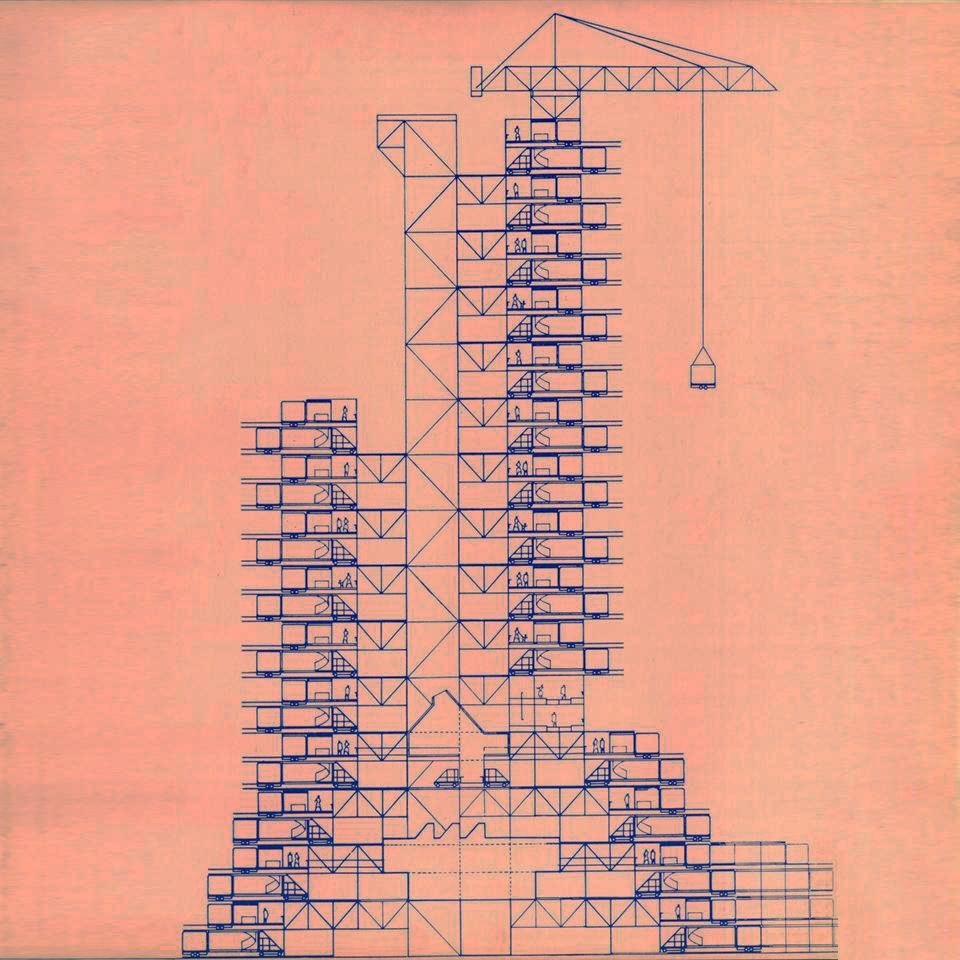Mobile home production has skyrocketed in the last few years. Architects are often inclined to take this development as a vanguard for a totally mobile future society in which the architectural hardware will be predominantly mobile and mass-produced. Aside from certain financial and legal implications (as for example obtaining ordinary mortgages and the resistance to zoning for mobile home parks) which can be changed in the future, one begins to question the mobile home in its existing form as a new conceptual alternative to existing housing types and one sees the dead end in this development:
1 - The mobile home in its existing form still reflects the outdated concept of a building as a prefixed assembled box with no potential to respond to the user's changing needs.
2 - Because of their low standard of technology the mobile homes are still bound to low-density living patterns.
3 - Paradoxically the mobile home has not enhanced mobility. Statistics have shown that mobile home dwellers move far less than the average population. The mobile home is simply too bulky in order to be conveniently moved. Including towing it can easily exceed $1000 to move the mobile home to another site, which may amount to 10% of the total value of the mobile home. Therefore people have preferred to move by selling and leaving the mobile home behind. Since this contributed to an enormously fast deterioration of the quality of some mobile home parks, a rule has often been established that no one can sell a mobile home which is more than five years old in the park and conversely that no one can move in with an older mobile home. Such regulations help to further limit mobile home mobility to a factory-site-site- junkyard mobility.
In order to keep pace with the demand for mobility many people have acquired an additional vacation mobile home or, as it is normally called, a "recreational vehicle", "camper", "trailer" which is basically a smaller version of the mobile home (self-propelled or non self-propelled). This is frequently, however, unused for about 10 to 11 months per year and is parked either in the driveway, backyard or in an additional parking structure. In this way the present trend leads to a doubling of housing containers and to a further redundancy within the architectural hardware. Today's building technology has not yet adjusted to these concepts to the inherent change in lifestyle. Newly arising problems are encountered by obsolete means and forms of structure. The trend today does not seem to lead to a mobility of shelter adequate to the social mobility.
1.jpg.foto.rmedium.jpg)
New concepts of housing, such as the plug-in and clip-on projects with all their sophisticated equipment for flexibility, have been generally planned only far change in long cycles. The units are changed when they become functionally obsolete or physically deteriorated or when the family size changes. In most cases change of family size means additional space has to be provided far eventual units to be plugged in (additional initial cost). Also change for growth of one family is only possible if the neighbour's family size decreases al the same time.
1.jpg.foto.rmedium.jpg)
The mobile housing system proposes:
All containers for living, such as house, trailer, car, garage, are integrated in one housing system consisting of a fixed space (unspecified space-adaptable to many functions) and several different mobile spaces, each designed far a special function.
The mobile space is planned either for change in short cycles for wheeled, self-propelled containers (daily) or for change in longer cycles far wheeled, non-self-propelled containers (weekly to yearly). Since the mobile containers serve specific functions and do not have the built-in potential to adapt to changing requirements, they might become obsolete earlier than the fixed unspecified space, which can adapt to changing requirements. The mobile containers are the disposable parts of the system and can be replaced separately whenever necessary.
Today's building technology has not yet adjusted to these concepts to the inherent change in lifestyle. Newly arising problems are encountered by obsolete means and forms of structure. The trend today does not seem to lead to a mobility of shelter adequate to the social mobility.
1.jpg.foto.rmedium.jpg)
Both types of mobile containers can be either clipped onto the fixed space to form a normal apartment type, or clipped together to form a variety of mobile shelters. The self-propelled container (electric engine) is driven directly to the fixed space either over ramps or through elevators and becomes a kind of extension of the living room. The seats can be turned and moved in a glide track. The concept of a self-propelled container as an extension of the living room might seem unusual today. But a car with record player, radio, convertible seats, cushions, curtains, etc., and with the potential to be used in drive-in restaurants, theaters, and other such facilities as dining room etc., is already a kind of a second living room today.
The non-self-propelled mobile units are attached to the fixed space from outside and fit into U-shaped cantilever tracks. In order to clip these units onto the self-propelled containers there is a special assembly area on the ground level apposite each car elevator. The assemblage of the various containers allow for a high number of different configurations, that means the housing module of a family can be dissected and reassembled according to the personal needs of the individual family members as smaller mobile or static units allow maximum of independence. The mobile housing system developed further within a larger context would make an integration of mobile containers with office, work, and public spaces (fixed spaces) possible. As an example, new types of motels and dormitories would consist only of a service structure and fixed spaces to which the individual mobile containers can be clipped on.
1.jpg.foto.rmedium.jpg)
Helmut C. Schulitz


